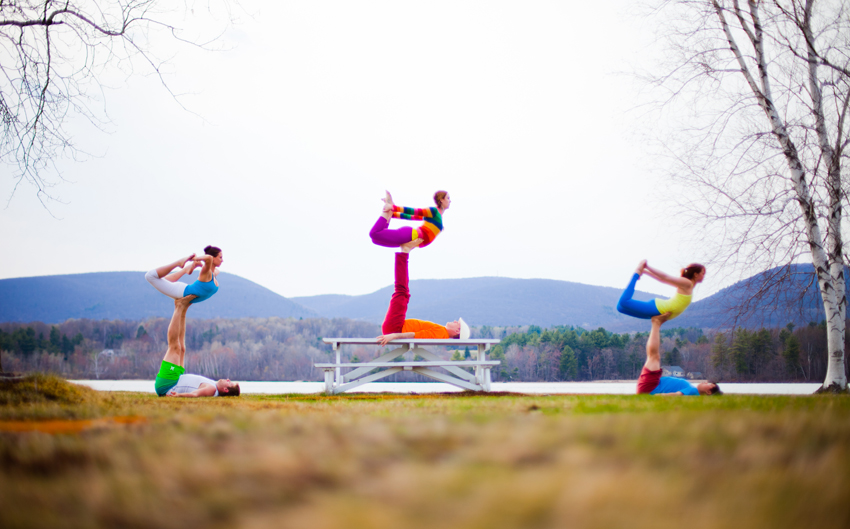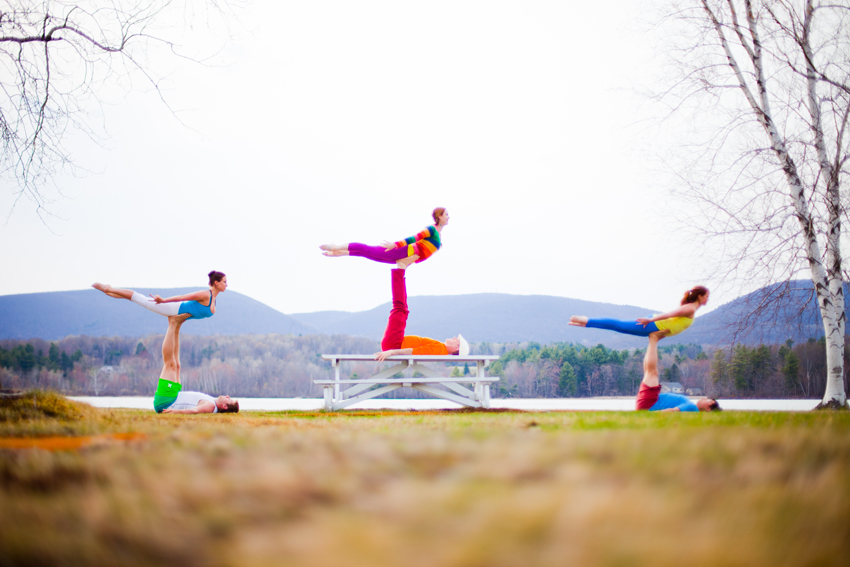Q&A: AcroYoga Instructor Patrick Donaher

AcroYogis in action. Photos by Wari Om Photography, provided.
If you, like us, still find yourself baffled at what other people can do in yoga class (Headstands? Arm balances? Really?), the idea of combining yoga with acrobatics is mind-blowing. But AcroYoga, a combination of partner yoga, acrobatics, and Thai massage, actually has a larger following here in Boston than you might know about. Patrick Donaher, a certified AcroYoga instructor who will be involved at Boston’s first AcroYoga festival in June, tells us what it’s all about.
First, what is AcroYoga?
AcroYoga is a fusion of partner yoga, partner acrobatic pratices, and Thai massage practiced with the idea of building community through this work. We have all kinds of folks here in Boston—computer programmers, professional performers, yogis, athletes— who probably wouldn’t meet in any other circumstances, but who come together regularly for Acro. AcroYoga tries to distill the unique powers of each—the body wisdom and care for the whole being of yoga; the discipline and communication necessary in acrobatics; and the Thai massage emphasis on healing touch and metta, or loving-kindness.
What’s the appeal of AcroYoga versus traditional yoga?
In my mind it’s not a versus. I teach a lot of “traditional” yoga, and I love it tremendously. The primary benefit of Acro is that everything we do has to be done together. All of these practices hinge on partnership, working with one or more people towards a common goal, be it an acrobatic routine or a massage. And all of the skills that working together requires—communicating clearly and compassionately, helping the other people build their skills as you build yours, knowing what you can and can’t do on a given day—make me better at so many of the other things I do.
How did you first get into AcroYoga?
I was in a private session with one of my teachers about eight years ago, and he “flew” me—put me on his feet and had me do a backbend upside-down. I was completely disoriented, startled, and exhilarated. A couple of years later, when studios started offering AcroYoga, I was hooked. We’re now in two yoga studios locally, and hope to be in many more venues by the fall.
Can anyone do it, or is this a skill best left to the experts?
If you can move, you can do AcroYoga. I’ve flown all kinds of people with all kinds of bodies. We play in the Public Gardens, and we’ve flown whole wedding parties! At the festival there will be multiple classes going on at once, with levels for people who are brand new to any movement practice and classes for dedicated practitioners. All you need is a willingness to play.
What can people expect of the festival?
A lot of fun, a lot of laughing, and a really good time. AcroYogis are a very welcoming community, and we are tremendously excited to share this practice with as many people as we can. Boston is really blessed to have one of the largest AcroYoga teaching teams in the country, so we’re hoping this is the next step to making Acro huge here in Boston.
Do you ever get scared while practicing? How do you learn to combine yoga and acrobatics?
These days, not much. One of the things that we’ve really drawn from the traditional yoga practices is the idea of working in safe, incremental stages to achieve challenging poses. As I’ve become more comfortable with both yoga and AcroYoga’s methodologies, I’ve found ways to work that are a lot less scary. That said, some of the things we do, even after my five years of practice, still require a certain leap of faith, and I’m lucky to have such great co-teachers and partners that I have that faith in.

Another AcroYoga pose.


